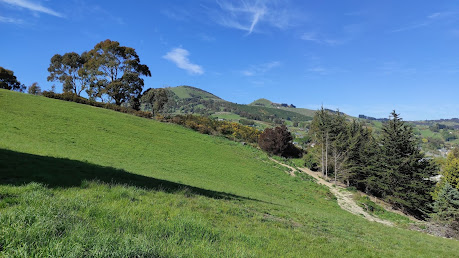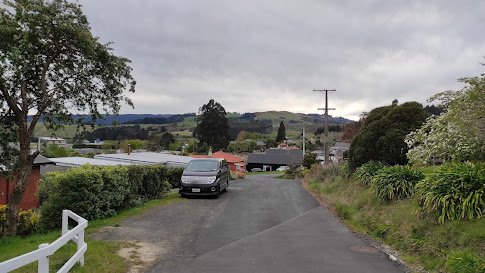Today I started walking the streets in Port Chalmers where I walked 7 streets
1532. George Street
1533. Beach Street
1534. Peninsula Beach Road
1535. Victory Place
1536. Wickliffe Terrace
1537. Albertson Avenue
1538. Blundell Avenue
Port Chalmers is the main port of Dunedin and has a lot of history which I was able to see through some of the historic buildings that I walked past today. It is in Port Chalmers in 1844 that the local Ngai Tahu tribe sold the Otago Block to the New Zealand Company.
A few years later in 1875, Port Otago was started and in 1882 the first frozen meat shipped from New Zealand to the Northern Hemisphere left from here. Today the port is still very much a major part of the township and is evident by the main street ending at the Port Otago yards with the container cranes dominating the view.
Very close to the town hall is where the first sailing ship, the John Wickliffe landed and the first settlers disembarked in 1848. This building was built in 1888 and was not just the town hall but also home to the Fire Brigade, the Police Station (including the Sergeant’s residence
and cells), Court Rooms, Customs Office and Government Shipping Office.
There was also a morgue that occupied a backroom downstairs. Today the bottom floor houses a public library and the top floor is available for functions.
Across the road from the town hall is the old Post Office built in 1877. The building now houses the maritime museum. Collections at the museum cover commercial fishing, shipping, Antarctic
exploration and social history.
During my walk, I crossed the Port Chalmers railway line which is the first railway line built in Otago in 1873. The railway line goes through a tunnel to finish at the port. This railway line is well used for taking containers and logs to and from the port to the city.
The port is a busy place with containers and logs. Today I didn't see any ships being unloaded but I was able to see the time ball on the hill overlooking the port which has stood on the hill since 1867 with the ball dropping at 1pm each day so ships officers could set their chronometers used in navigation. The time ball was used up until 1931.
I walked around, past the port to Back Beach. Back Beach is at the 'back' of Port Chalmers and isn't much of a beach. It is more of a place to launch boats and has a number of boat sheds.
The view from Back Beach is beautiful looking across to Goat Island, Quarantine Island and the hills of the peninsula behind. It is from here the water taxi leaves to make the journey across the harbour to Portobello.
From Back Beach, the road winds it's way around the bottom of Port Chalmers, close to the water of the harbour. This is a narrow, gravel road that is a popular walk for locals.
This road is a good place to be able to see in both directions down the harbour. It also shows how narrow parts of the harbour are and why Port Chalmers is the preferred port for large ships. This pictures shows how close Port Chalmers is to Goat Island and then a small gap to Quarantine Island. The road I am walking runs around the base of Port Chalmers, close to the water.
I was able to look across to the hills of the peninsula and Harbour Cone which is the pointy hill on the right. The houses below Harbour Cone are part of Portobello and are streets that I have not walked yet.
And then I was able to look down the harbour towards the city. The habour really opens out the further you travel down to the city where it narrows again.
As I rounded the corner and walked back towards the township of Port Chalmers, I was able to look across to Sawyers Bay where I had been walking yesterday. I have walked all the streets that I could see.
Then I was back into the streets with houses and I was able to look across to streets that I have not walked yet. This is the area that I will be walking over the next few walks as I near the end of my challenge to walk every street in Dunedin.
One area I walked past was this spot where the steam ship 'Pride of the Yarra' sank in July 1863. Thirteen people drowned here, including the first rector of the new Dunedin High School (now Otago Boys High School), Reverend Thomas Campbell, his wife and and five children who had just completed a 3 month journey from London.
On my walk around from Back Beach, I followed the Writers Walk which is a trail of 11 concrete plinths each bearing poetry written by a member of the Writers Group.
I walked past two pieces of art today. The first is huge and is on the side of a Port Otago warehouse and is of a boat on the back of a whale which I thought was great. I am not sure what the second piece of art is but it is interesting none the less.
This map shows the streets in Port Chalmers that I have walked are highlighted in red
Distance walked: 5.5 km Walking time 59 mins
Total distance: 938.2 km Total walking 174 hr 57 mins































































